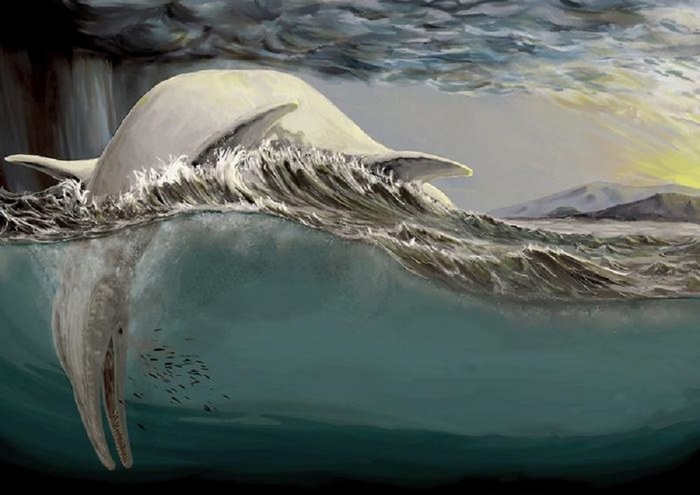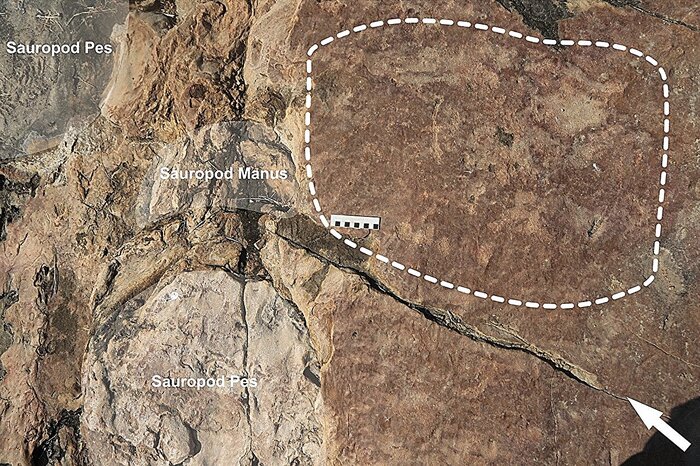Enlarge image
Artistic reconstruction drawing of Mussaurus patagonicus
Photo: Jorge Gonzalez
When paleontologists find a well-preserved dinosaur skeleton, that's a great and rare find.
But it's nothing compared to what researchers have discovered in Argentina.
The find is so extensive that it even provides insights into the social life of early herds of dinosaurs.
On an area of one square kilometer in the south of Patagonia, a team discovered 80 individuals of different ages and over 100 partially well-preserved fossilized eggs of the species Mussaurus patagonicus.
“It's hard to find fossilized eggs at all.
And it is even harder to discover fossilized eggs with embryos in them, «the dinosaur expert Diego Pol from the Museo Paleontológico Egidio Feruglio in Trelew is quoted in a communication.
The paleontologists had already described some animals at the Laguna Colorada site.
But now the international team around Pol is presenting a comprehensive evaluation and interpretation of the exceptional find.
The study shows that these large herbivores lived in flocks about 193 million years ago, maintained common breeding colonies and grouped together according to age groups.
"Our most recent expeditions to the site have produced 69 new specimens of M. patagonicus, in addition to the 11 individuals that have already been discovered," writes the team.
"The new specimens include skeletons at six different stages of development, ranging from embryos to fully grown animals." There are also more than 100 eggs.
Most of the eggs lay in clutches.
These each contained eight to 30 eggs and were close together.
Therefore, the team assumes that these are breeding colonies.
Not far from there were eight tiny animals that weighed an estimated 70 grams and had probably just hatched - apparently all at a similar time because of their comparable size.
50 meters away, the team came across the closely spaced remains of at least eleven adolescent animals, which were also of similar size and weighed around ten kilograms.
They probably died at the same time towards the end of their first year of life.
Elsewhere discovered that nine other individuals were already older, with a weight between 106 to just under 560 kilos, but were far from fully grown.
The several meters tall dinosaurs could weigh up to 1.5 tons.
Adult animals were also found - some of them close together.
Survival thanks to herd instinct
The species M. patagonicus is one of the sauropodomorpha, which also includes the gigantic sauropods that emerged later.
At the end of the Triassic period about 200 million years ago, the sauropodomorpha had already displaced many other herbivores.
After surviving the great extinction of species at the end of the Triassic period, they were the only large herbivores and dominated many terrestrial ecosystems for millions of years.
So far, experts have seen the reasons for their success in occupying ecological niches that have become vacant, in their height and their rapid growth.
The study, which has now been published in the journal "Scientific Reports", indicates that these characteristics were associated with their social behavior.
The team wrote that dinosaurs formed herds more than 40 million years earlier than previously known.
"The common occurrence of newly hatched, growing and adult animals in the same place and in the same shift indicates that the individuals maintained social cohesion over different phases of their lifespan." The separation according to age groups is a main characteristic of herd animals and also of large ones herbivorous mammals well documented.
Sauropodomorpha breeding colonies were previously suspected of two other species in China and South Africa.
The researchers therefore assume that this behavior was already present in the common ancestors of the three species in the late Triassic - at least roughly 210 million years ago.
The team speculates that social behavior may also be related to the increase in the body size of these dinosaurs.
According to this, large animals have a particularly high energy requirement, for which they in turn need larger habitats and have to cover greater distances every day - which is safer in herds.
Hence, social behavior may have contributed to the success of this group.
"They are not the oldest dinosaurs, but the oldest for which herd behavior is suspected," says Pol.
“Mussaurus belongs to the first successful family of herbivorous dinosaurs.
So we suggest that social behavior and the collective protection of the young offered by the herd may have contributed to these long-necked dinosaurs spreading across continents. "
joe / dpa









